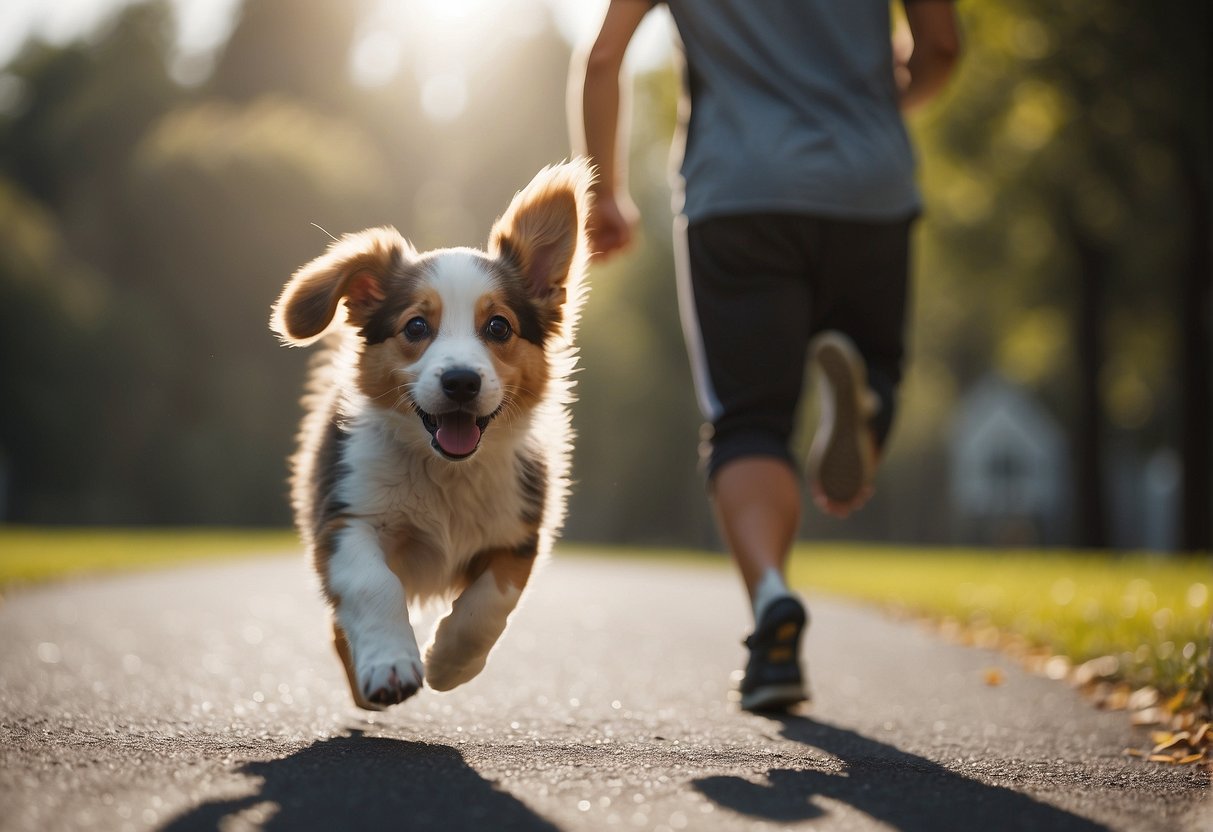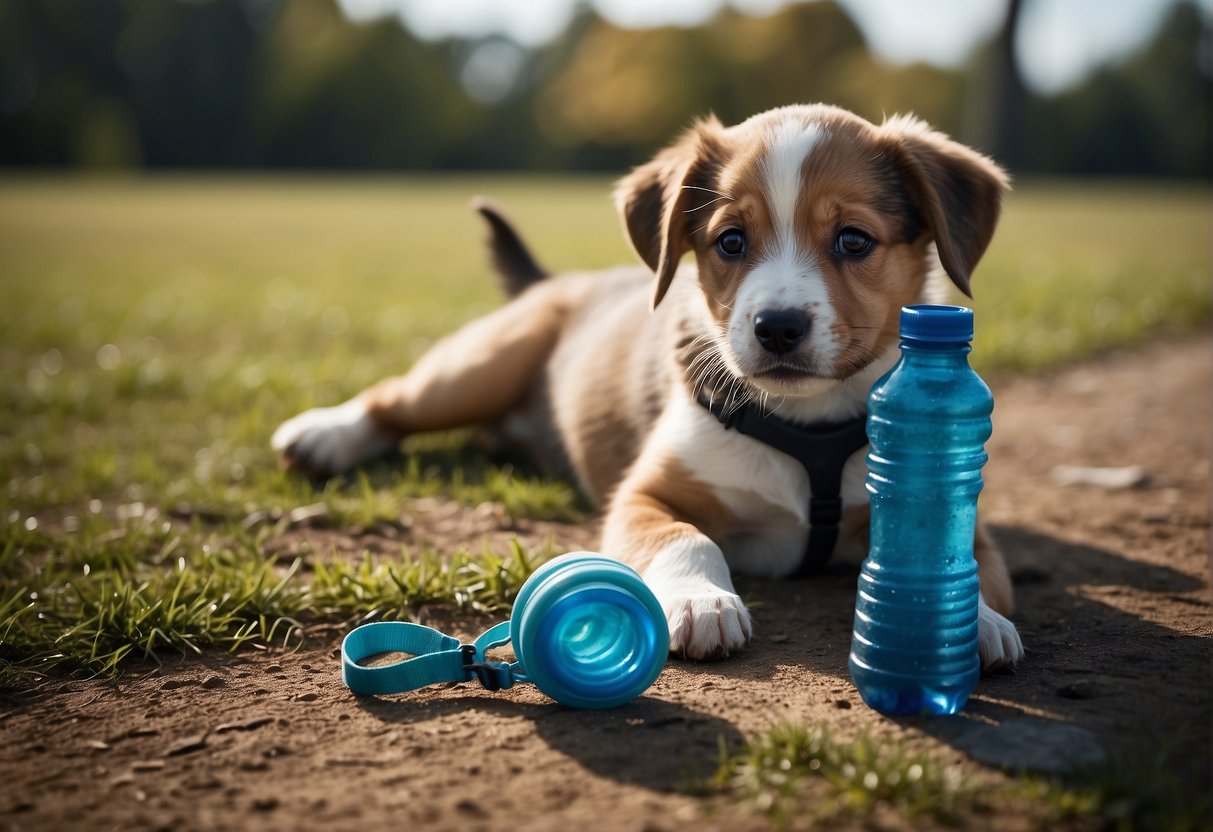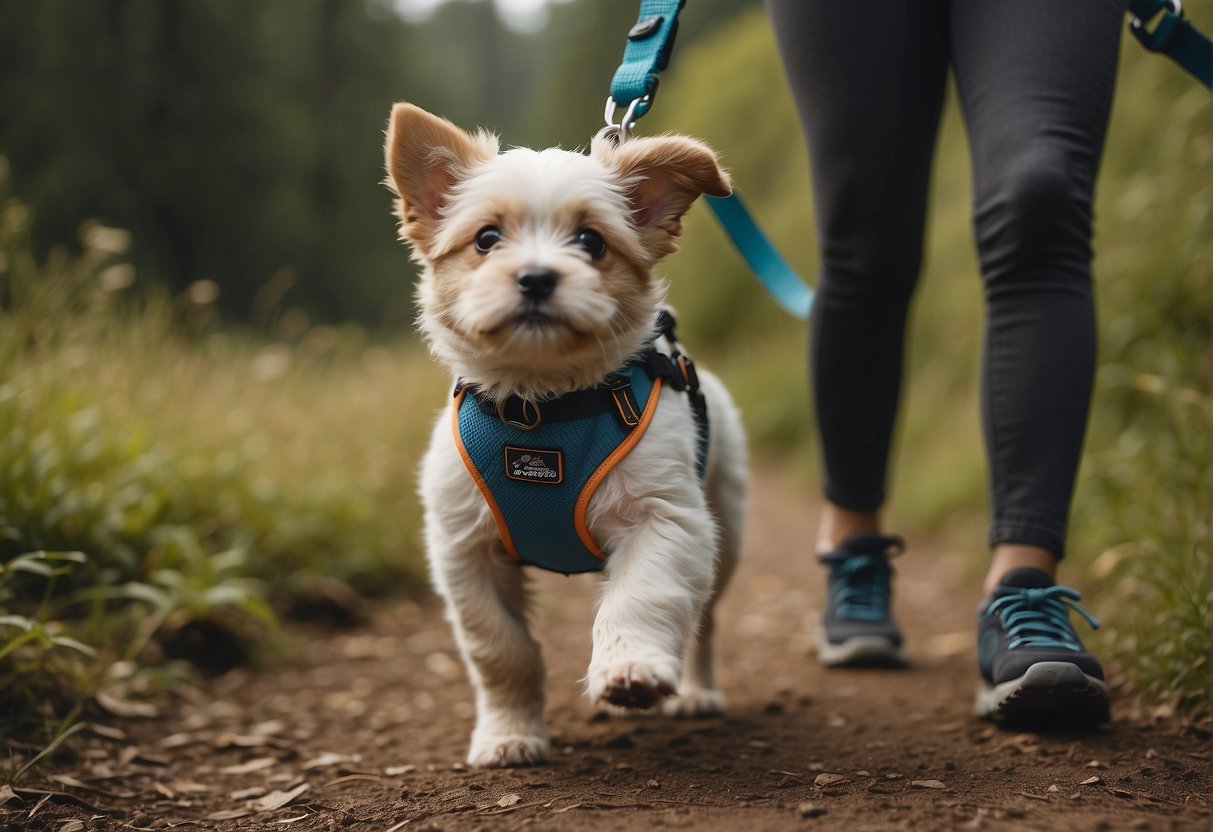Determining the appropriate time to start running with a puppy is important for the health and safety of your growing dog. Since puppies have developing bones and joints, it’s essential to wait until they’ve reached a stage where their bodies are ready for the rigors of running. For most dogs, this is usually around 18 months of age, with variation depending on the breed and size of the dog. Larger breeds often need more time before their growth plates have fully closed, and running too soon can lead to joint damage or other health issues.

Before embarking on a running routine with your puppy, it’s necessary to consider their physical preparedness and individual needs. Each dog is different, and factors such as breed, size, and health can greatly affect their ability to participate in and enjoy running exercises. Preparing to run with your puppy entails more than merely hitting the trail; it involves understanding and responding to your dog’s cues, gradually increasing exercise intensity, and acknowledging the importance of rest and recovery.
Key Takeaways
- Puppies generally should not start running until about 18 months old.
- Readiness for running varies greatly among breeds and individual dogs.
- Proper preparation and gradual introduction are essential for running with puppies.
Understanding Puppy Development

When considering when to start running with a puppy, it’s essential to comprehend the stages of their development during their first years, as well as the point at which they reach physical maturity.
Puppy’s First Years
Puppies go through rapid growth and development in their first months of life. They transition from dependency on their mother to a more autonomous, curious stage akin to a human child. By the age of six months, puppies are often in their adolescent phase—an intermediate stage before becoming an adult dog. This period is marked by increased energy and a need for socialization, training, and structured exercise. However, their bodies are still developing and care must be taken to avoid overexertion.
Physical Maturity and Running
Determining the right time to start running with a puppy relies heavily on their breed and size. Smaller breeds generally reach maturity faster than larger breeds, which can be fully grown by the age of one to two years. It’s commonly advised by vets to wait until a puppy is at least nine months old before incorporating running into their exercise regimen. For large and giant breeds, exercise that’s too strenuous, too soon, can harm growing joints and bones. Therefore, leading authorities recommend waiting until a larger dog is over a year old, and sometimes up to 1.5 years, before starting more impactful activities such as running.
Breed Considerations for Running

When deciding to run with a puppy, understanding breed-specific traits is essential for their health and enjoyment. Some breeds are natural runners, while others require caution due to physical characteristics or growth patterns.
Best Dog Breeds for Running
Certain breeds are well-suited for running due to their high energy levels and physical endurance. Examples include:
- Border Collie: Renowned for their agility and stamina, ideal for long-distance running.
- German Shorthaired Pointer: Built for speed and known for their powerful legs.
- Husky: Bred for endurance, huskies can handle long runs in cooler climates.
- Labrador Retriever: Energetic and strong, great for jogging and moderate running.
- Jack Russell Terrier: Small but mighty, with an abundance of energy ideal for sprinting.
Breeds to Exercise with Caution
Some breeds face challenges when it comes to running, mostly due to respiratory and joint issues:
- Brachycephalic Dogs (e.g., Pugs, French Bulldogs, Boxers): Their short snouts make breathing difficult during intense exercise.
- Large Breeds with Joint Concerns: Heavy builds can be prone to joint issues, so running may need to be limited.
Puppy Breed Specific Exercise Needs
Running with puppies requires a nuanced understanding of their physical development:
- Endurance Breeds (like Huskies): May start with short, informal runs after reaching sufficient maturity, around 1.5 years old to prevent damage to growth plates.
- Brachycephalic Breeds: Exercise should be mild and monitored closely due to their respiratory limitations.
- Smaller Breeds (such as Jack Russell Terriers): Can often start running earlier at about 9 months, but always confirm with a vet to be sure.
It’s important to note that regardless of breed, each puppy is unique and may have individual constraints or abilities. Always consult with a veterinarian to ensure a running regimen is appropriate for a specific puppy’s health and breed characteristics.
Preparing to Run with Your Puppy

Before embarking on jogs with your puppy, it is critical to ensure they are physically prepared and have a foundation of obedience training. This preparation safeguards their well-being and sets the stage for enjoyable running experiences together.
Health Check-Ups and Vaccinations
Before starting any running regimen, puppies must receive a health check-up from a vet to ensure they’re in good shape for physical activity. A vet can confirm that the puppy’s growth plates have closed, which typically happens around 18 months for most breeds, indicating they are ready for more strenuous exercise. It’s also essential to ensure that puppies have completed their vaccination schedule to protect them from diseases they may encounter in the outdoors.
Basic Obedience Training
Training your dog in basic obedience is crucial for a safe running experience. Commands like sit, stay, and heel are fundamental, but perfecting a bomb-proof recall can prevent potentially dangerous situations. A recall ensures that your puppy can return to you promptly on command if they get off-leash. During training sessions, positive reinforcement using rewards and treats is effective and helps in building a strong bond.
Building a Routine
Gradually building up a running routine is advised for a puppy. Start with short walking intervals to build their stamina, and then incrementally introduce running segments as they grow older and stronger. Adhere to a consistent schedule, as erratic training can cause confusion and stress for the puppy. Consistency helps in establishing a routine that the puppy can anticipate and enjoy, linking running with positive reinforcement and rewards.
Running with Your Puppy Guidelines
When incorporating running into a puppy’s routine, it’s crucial to approach this new activity with patience and awareness of a puppy’s physical development and endurance. Addressing the specific needs and limitations can ensure a safe and enjoyable experience for both puppy and owner.
Safe Starting Practices
Most veterinarians agree that one should wait until a puppy is at least 9 months old before initiating running routines, with larger breeds often needing to wait longer—potentially over a year. The joints and growth plates in puppies are still developing, and too much strain too early can lead to health issues later in life. Owners should start with short distances and gradually increase as the puppy grows, following the guideline of 5 minutes of walking per month of life.
Understanding Puppy Endurance
Puppies, much like young children, have varying levels of endurance. Begin with intermittent periods of jogging, balanced with walking. Pay attention to the puppy’s behavior: signs of fatigue or reluctance should not be overlooked. It is also important to note that certain breeds may have specific limitations when it comes to endurance and the type of exercise that is suitable for them.
Running Under Different Weather Conditions
Running with your puppy under optimal weather conditions is significant to avoid any risk of heatstroke or hypothermia. Puppies are less able to regulate their body temperature, so running in extreme weather—either hot or cold—can be dangerous. Choose cooler times of the day during summer months and make sure your puppy is always well-hydrated; in cold conditions, they may require protective clothing or shorter runs.
Practical Tips for Running with Your Puppy
Before introducing a puppy to running, it’s vital to understand that patience, gradual training, and attentive care are key to creating a healthy, happy, and capable running buddy.
Training Your Puppy to Run
Training a puppy to run alongside you requires starting with the basics of loose-leash walking to ensure the puppy learns to follow your speed cues without pulling. Gradually increase the duration and intensity of the exercise sessions, always watching for signs of fatigue or disinterest, which indicate it’s time to rest.
- Basic Training Steps:
- Begin with short walks to build stamina.
- Introduce jogging intervals in your walk.
- Use positive reinforcement when your puppy maintains the pace.
Monitoring Your Puppy’s Exercise Levels
Puppies are still growing, so their exercise needs are different from those of an adult dog. It’s crucial to monitor their physical responses to running, as over-exertion can lead to injuries, especially in their formative months when their growth plates are still developing.
- Exercise Monitoring Tips:
- Start with a slow, short-distance jog and incrementally increase.
- Look for fatigue signs: heavy panting, lagging behind, or reluctance to continue.
- Consult with a vet or use recommendations from puppy coaches on apps like Zigzag for tailored exercise plans.
Nutrition and Hydration
A well-balanced, nutritious diet, along with proper hydration, is essential for a puppy with an active lifestyle. Puppies require more calories and nutrients than adult dogs, so their diets must support their energy output and growth needs.
- Dietary Considerations:
- Ensure a balanced diet appropriate for a puppy’s age and size.
- Provide fresh water before and after running to maintain hydration.
By following these tips and consistently monitoring your puppy’s needs, you can foster an enjoyable and sustainable running routine for both you and your puppy.
Dog Running Safety and Care

Ensuring a safe running experience for dogs involves preventing injuries, being prepared for emergencies, and providing proper care after exercise. A dog owner should tailor this approach depending on their pet’s age, breed, and health condition.
Preventing Running Injuries
To prevent running injuries in dogs, owners should start with:
- Moderate Exercise: Begin with short distances and gradually increase the intensity and duration following a vet-approved exercise routine.
- Surface Awareness: Run on soft surfaces such as grass or dirt to cushion your dog’s joints, avoiding asphalt which can be hard on their paws and joints.
They should also incorporate:
- Agility Training: Simple agility exercises can improve a dog’s coordination and fitness levels, reducing the risk of injuries.
- Proper Warm-Up: Before running, warm up your dog with a brisk walk or mild play to help prevent muscle strains or other injuries.
First Aid and Emergency Preparedness
A dog first aid kit should include:
- Basic Supplies such as bandages, antiseptic wipes, and tweezers for removing splinters or ticks.
- Emergency Information like the number for the nearest veterinary hospital and the ASPCA Animal Poison Control Center.
An owner should also be aware of:
- Common Injuries: They should know signs of overheating, dehydration, and exhaustion, as well as how to respond to them.
- CPR for Dogs: Basic knowledge of canine CPR can be life-saving in case of an emergency.
Post-Run Recovery and Care
After a run, it is crucial to provide:
- Cool Down: A cool-down period with a slow walk to help the dog’s muscles relax and prevent cramping.
- Hydration: Fresh water should be readily available to avoid dehydration.
Furthermore, owners should:
- Check the Paws: After running, inspect the dog’s paws for cuts, scratches, or sores.
- Monitor Behavior: Post-exercise, monitor the dog for any signs of discomfort or pain that could indicate an injury.
By following these guidelines and taking an informed and proactive approach to their dog’s running sessions, owners can significantly reduce the risk of injury and ensure that their dog remains healthy and happy.
Frequently Asked Questions

When introducing a puppy to running, it’s crucial to consider their age, breed, physical readiness, and the need for gradual training. Below are some specific questions and answers to guide you in this process.
At what age is it safe to begin jogging with a golden retriever puppy?
It’s generally safe to start jogging with a golden retriever puppy once they are about 9 to 12 months old. This is when their growth plates would have matured enough to handle the activity.
What is the appropriate distance to run with an 8-month-old puppy?
For an 8-month-old puppy, short runs of only a few minutes, mixed with walking, are advisable. Gradually increase the distance as the puppy grows older and shows signs of being comfortable with the exercise.
What are the signs that a puppy is ready for running exercises?
A puppy may be ready for running if they display high energy levels during walks, appear physically coordinated (not tripping over themselves), and are mentally attentive. Moreover, lookout for the puppy’s eagerness to keep moving without signs of discomfort or lethargy.
How do you train a dog to run alongside you without pulling on the leash?
Training begins with leash manners during walks. Encourage your dog to run by your side with positive reinforcement, such as treats or praises, whenever they don’t pull on the leash. Practice consistent commands and keep the training sessions short to maintain their focus.
What are the benefits of including your dog in your running routine?
Incorporating your dog into your running routine can boost their physical health, help control their weight, and improve cardiovascular fitness. Additionally, it strengthens the bond between owner and pet, providing a shared activity that both can look forward to.
What precautions should be taken when starting to walk or run with a large breed puppy?
For large breed puppies, it is crucial to wait until they are older before beginning to run—usually around 12 to 18 months. They should start with short, slow walks, gradually increasing to running. Always monitor for any signs of discomfort, pain, or fatigue.
